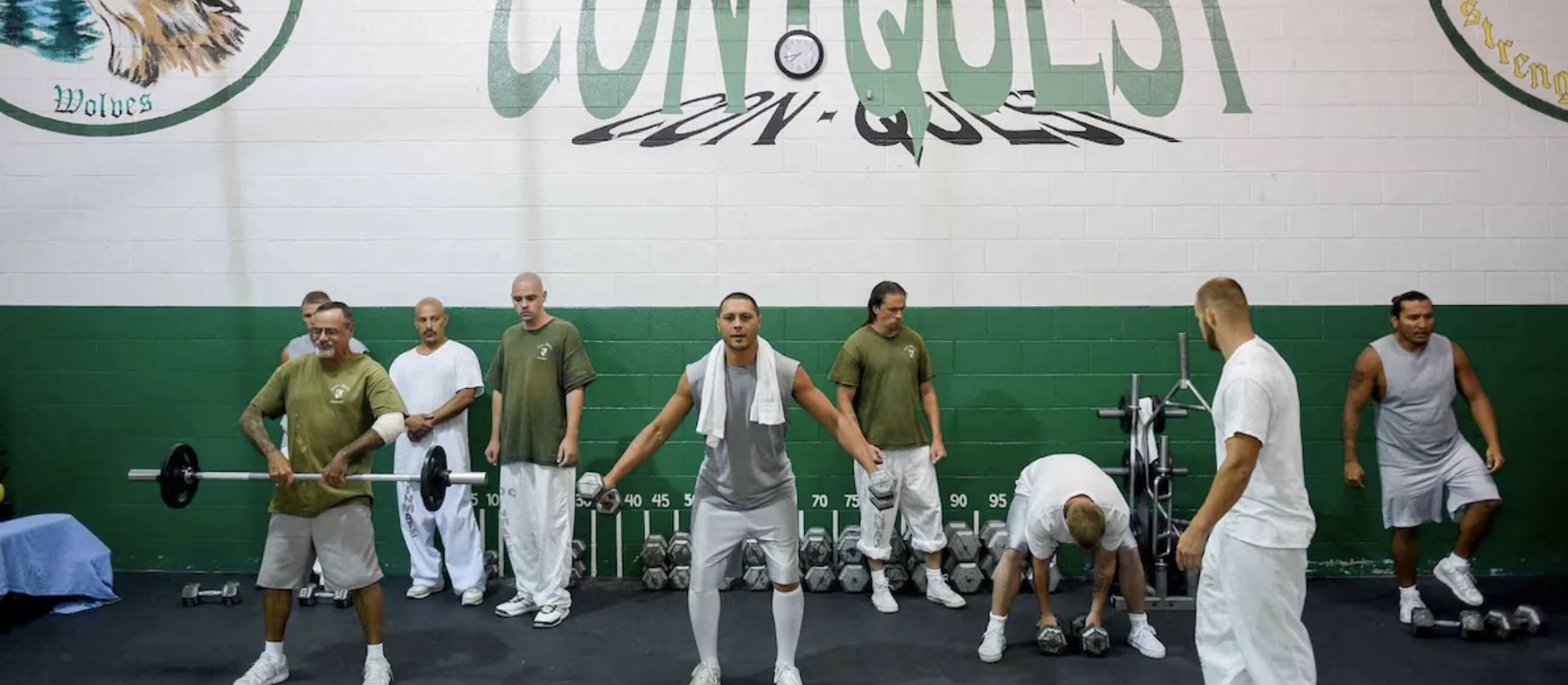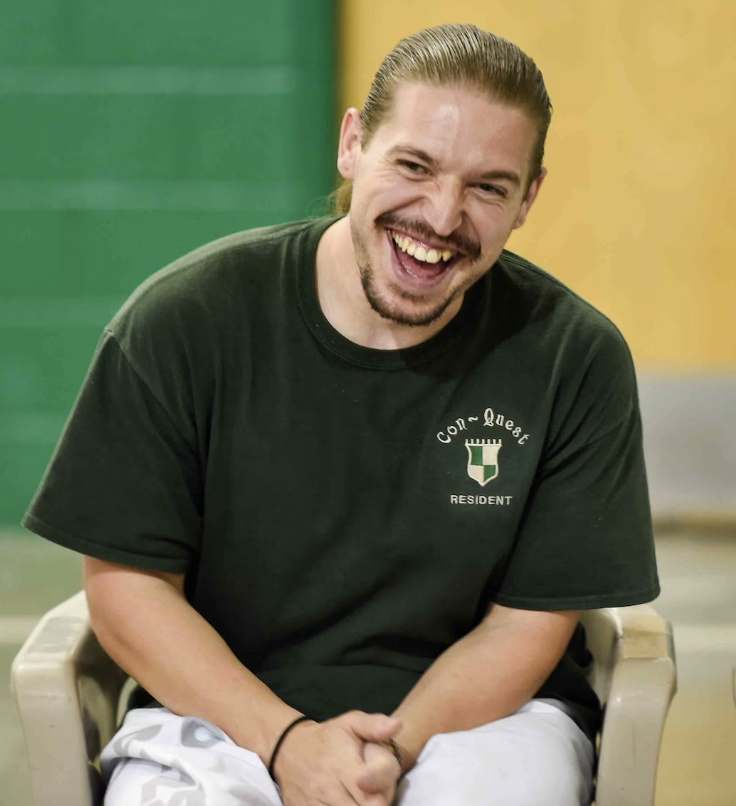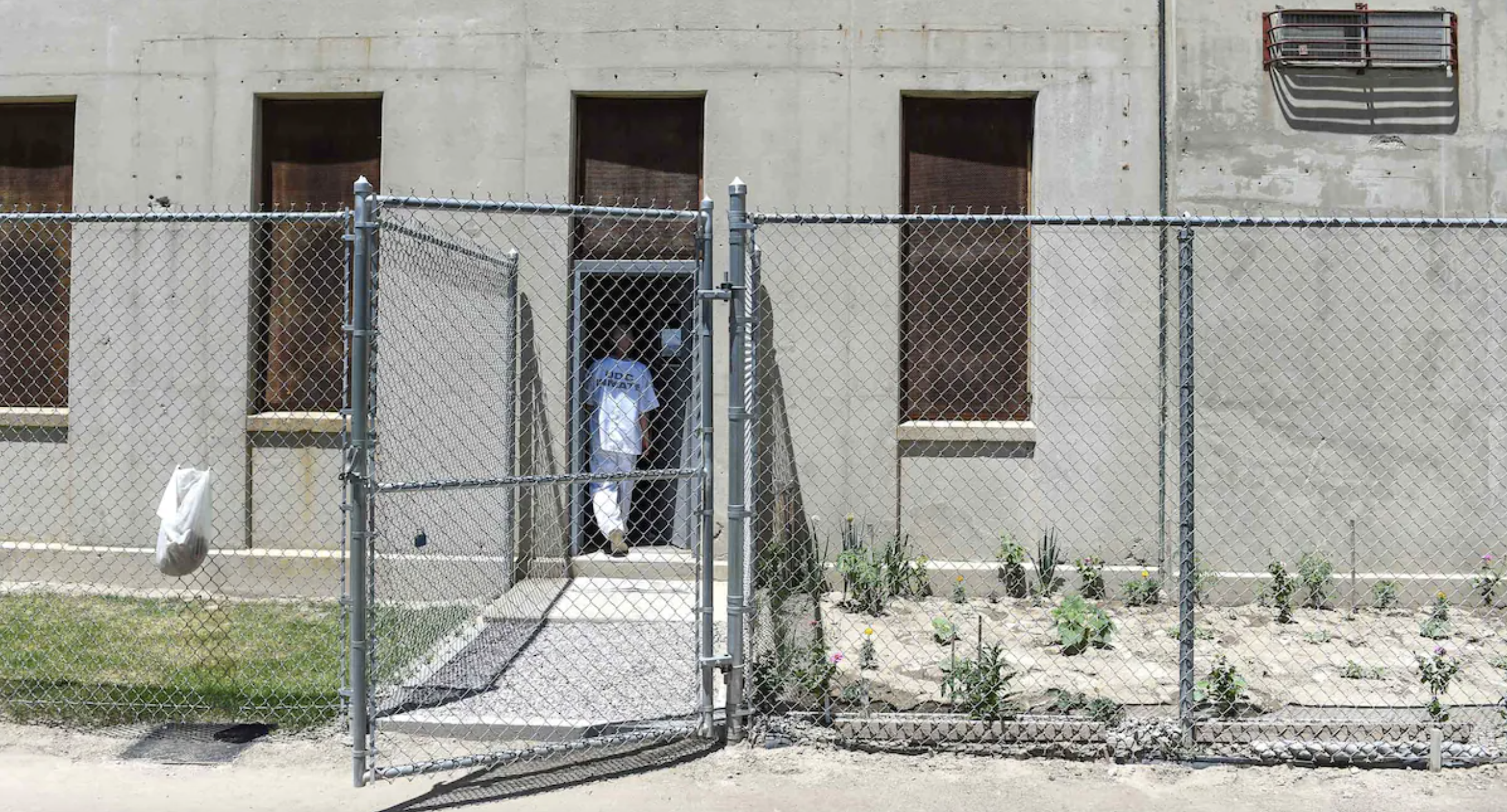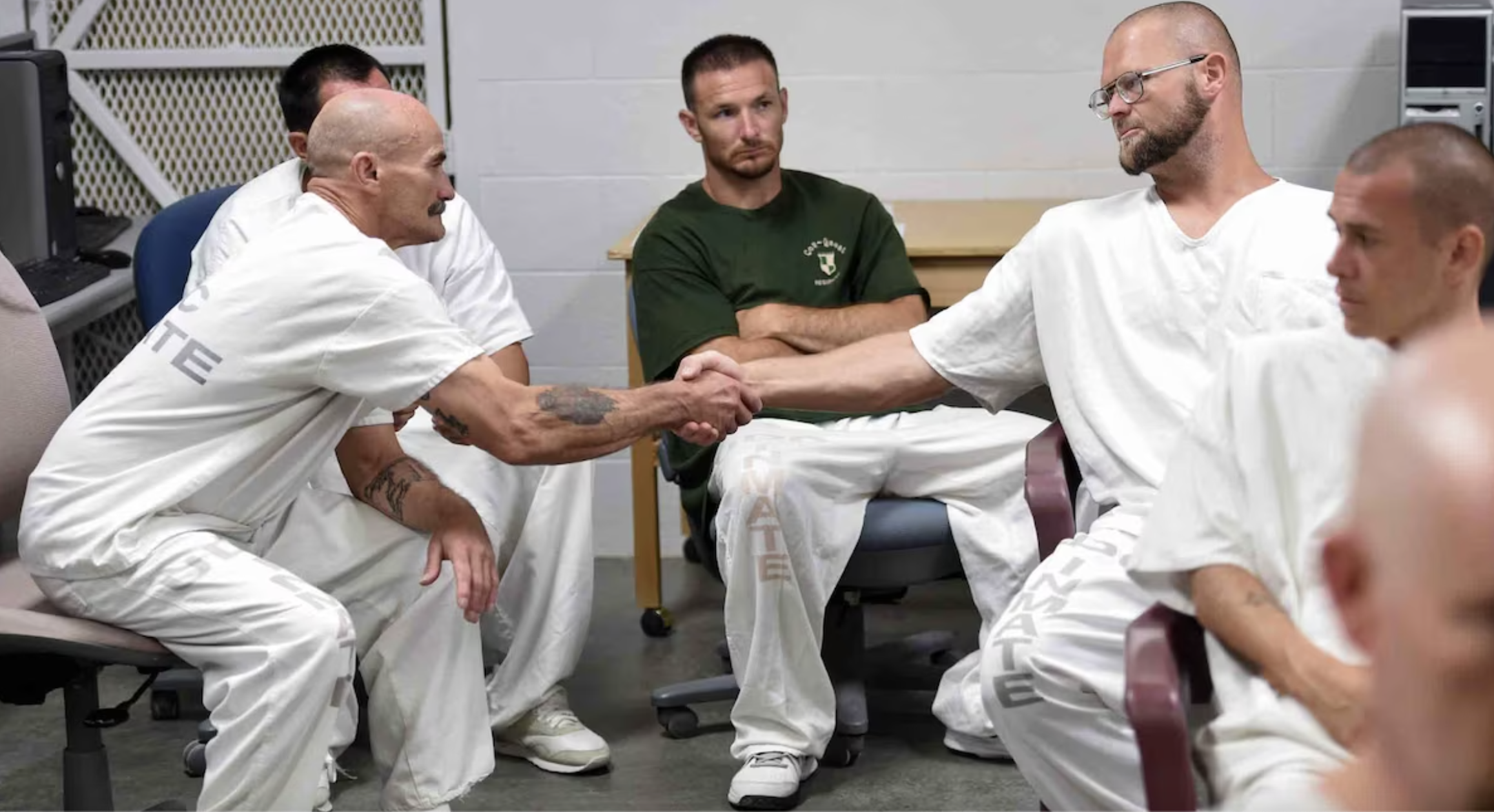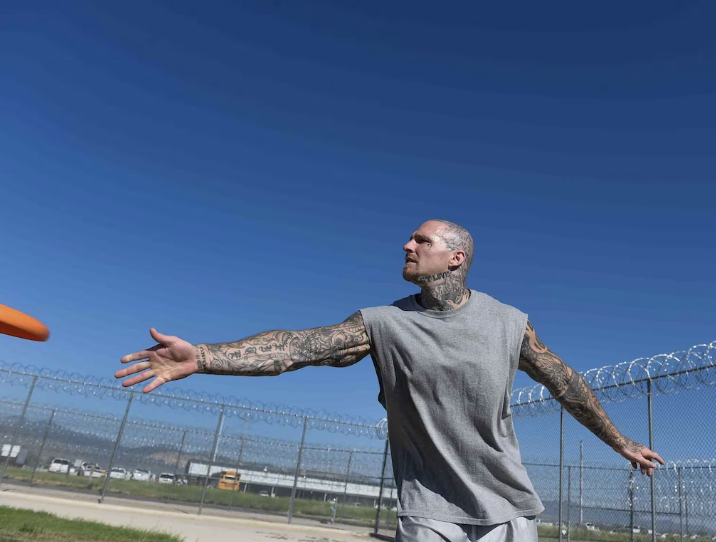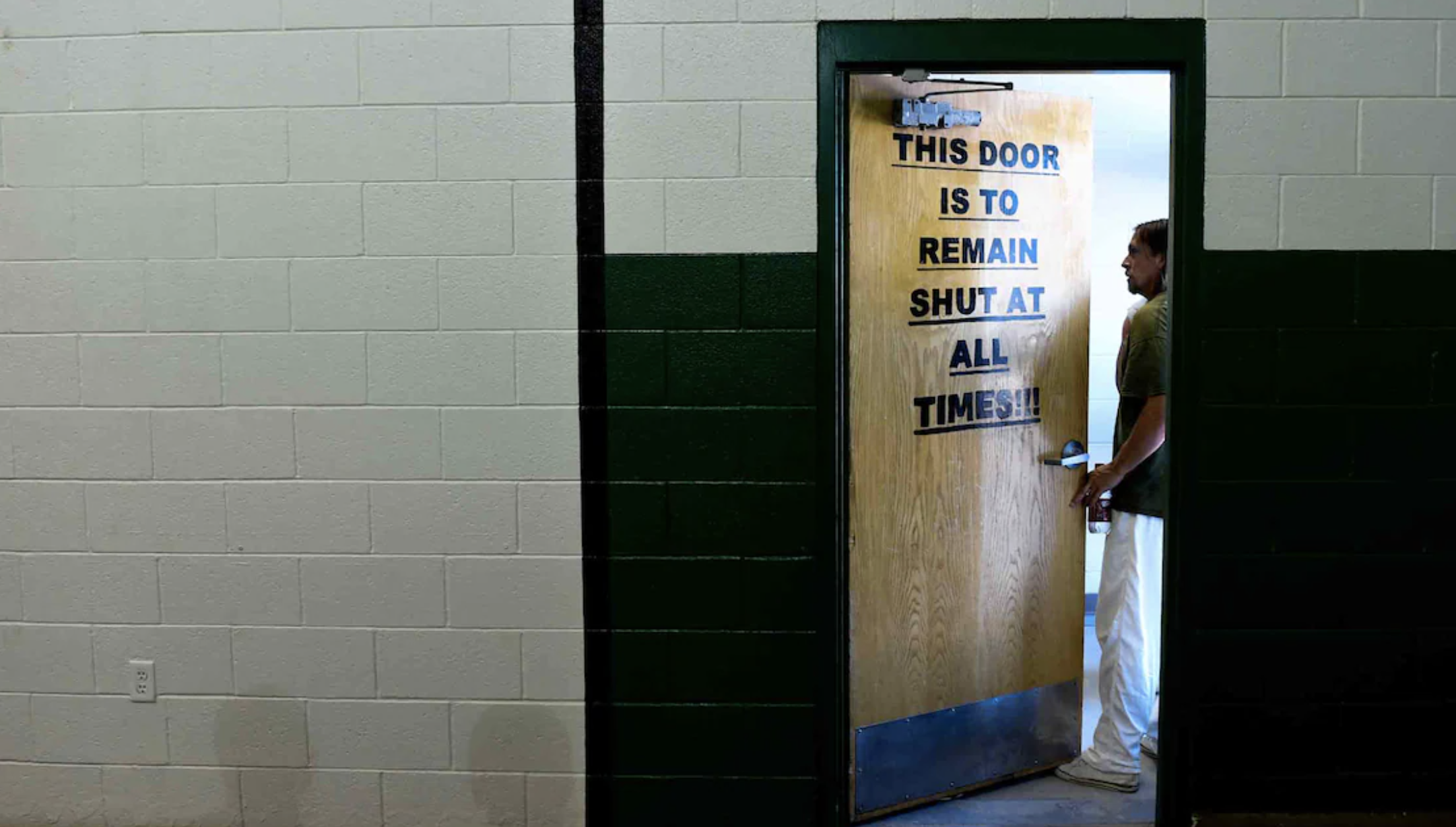Washington Post: A Game Of Healing At The Utah State Prison
July 2, 2015 DRAPER, Utah — The prison’s small gym had begun to smell like sweat. The room was filled with heavy breathing, grunts and inmates counting their reps. In one corner, a group huddled around a prisoner on the bench press, spotters standing ready at either side with a third behind him. A prison therapist observed from one corner.
“It’s a really cool process to see,” Kari Bennett said. “They form these bonds while working out, helping them to connect with peers, process emotions, talk to each other about what’s going on.”
Above: In the Addict II Athlete program, Thursdays begin with a weightlifting class, and all sessions include a 30-minute group discussion about addiction and sobriety.
While most American prison systems utilize sports and exercise to help maintain peace and order in a stress-filled, volatile environment, the Utah Department of Corrections has incorporated sport in the rehabilitation of some inmates, using team games and regular exercise as part of a coordinated therapy program.
The Utah system is filled with men who’ve committed crimes big and small, both trivial and heinous. But prison officials are trying to rehabilitate them all just the same, punishing convicts for their crimes but also giving them the tools so they don’t become repeat offenders.
About 45 minutes into a recent morning weightlifting class in the Promontory facility, a lower-security part of the state prison system that houses the Con-Quest program for drug and alcohol addicts, inmate Kurtis Hunsaker began grabbing plastic chairs and positioning them in a circle, not far from a basketball hoop at one end of the gym.
With a cement floor and cinder block walls, the gym feels like something you might find on a middle school campus — aside from the trio of guards keeping watch from one corner. Logos from the facility’s eight dormitories are painted on the walls, including the Falcons, Cougars and Lions. As the inmates finished their final reps, they retrieved water and towels, and each took a seat in the circle.
The group is called Addict II Athlete, and it meets three times a week, every session built around sport, discussion and rehabilitation. Tuesdays and Fridays might include basketball, softball or running. Thursdays begin with a weightlifting class. Most games in prison have the familiar rules with minor wrinkles: In Ultimate Frisbee, for example, when a disc hits the fence, it sets off an alarm in the control room and is therefore considered a turnover; and in softball if the bat comes into contact with a person, the game is automatically over.
Each session includes a 30-minute group discussion about addiction and sobriety, about pressures felt inside these walls and fears about what lurks beyond them. Using sport as a catalyst for discussion, they explore identity, the root of their addictions and discuss ways their future will be different from their past.
“I got one thing,” Nestor Lujan told the group. “Pretty soon I’m out. I’m about five weeks from getting out. I don’t know what I’m gonna do.”
Lujan is a 40-year-old inmate with the block letters “Brownpride” tattooed on the back of his shaved scalp. He has been in and out of prison most of his life, and by now, he knows it’s easier to get in than to stay out.
“I’m scared,” he said.
In the Addict II Athlete program, Thursdays begin with a weightlifting class, and all sessions include a 30-minute group discussion about addiction and sobriety.
‘Part of my regular life now’
Most of the men in Addict II Athlete are in on drug-related charges: using, selling, stealing to support a habit. Because they have been accepted into the prison’s Con-Quest program, each is required to participate in a therapy program. Groups such as Alcoholics Anonymous, Narcotics Anonymous or a church-sponsored 12-step program don’t speak to everyone, so early last year, prison officials adopted Addict II Athlete, a small support group that had found some success in Utah communities by using sport — particularly running — to help men and women confront the torments and temptations of addiction.
Nestor Lujan is scheduled to be released from prison next month, but says,“I don't know what I'm going to do. ... I'm scared.”
“They already have the negative labels of inmate or drug user or addict,” said Blu Robinson, a drug counselor and founder of the group. “What I say is, ‘Let’s erase all that and call you what you really are: You’re an athlete; you’re a champion; you’re a father, a son.’ They start building onto that so that they can have a better view of who they are.”
In the gym, Lujan listed his concerns about his July release date. He has been a drug user more than half his life, in and out of prison for the past 20 years. He doesn’t want to come back.
“I think he’s more worried about change,” offered a fellow inmate, Jake Vanderwoude, “being stabilized in here, as opposed to going out there and taking on all the responsibility.”
They suggest ways Lujan can stay clean and maintain healthy habits. Many here consider sport essential to enduring life inside prison and also having any chance at surviving outside of it. On the track, on the weight bench and in therapy, they work together to understand their flaws while confronting the consequences of their dumb mistakes and poor decisions. One key for Lujan, they agree, is to keep exercising.
Inmate Larry Davis is spotted by Kurtis Hunsaker during their Addict II Athlete program, where therapists noticed that inmates weren’t just tackling their own addictions; they’d taken an interest in the sobriety of others.
“I’ve never wanted to say, ‘Hey, let’s do some drugs and then go work out.’ That’s never happened,” inmate Larry Davis said.
Lujan thought about it. He had hoped he had finally wiggled free from addiction’s clenched fist. He has a wife waiting on the outside, a kid, a loving mother, too. For him, this time felt different.
“I’ve never been an AA or NA kind of guy anyways,” Lujan said. “This right here is probably the best support group, the best setting, the best type of people. This isn’t something I’m doing just while I’m here. This is part of my regular life now. I’m always going to work out wherever I go, whatever I do. If I stop working out, then I’m probably starting to do really bad in life.”
After more than 30 minutes, the conversation began to wind down. The inmates stacked their chairs and left the gym, some for a therapy appointment, a few back to their dorm and most counting the hours until their next workout.
A different kind of prisoner, through blood, sweat and tears
In Utah, the program “Addict II Athlete” is helping a group of men plan new lives through tough workouts and tougher love.
A different kind of prisoner, through blood, sweat and tears
In Utah, the program “Addict II Athlete” is helping a group of men plan new lives through tough workouts and tougher love.
In it, together
Hunsaker, 26, is one of the peer leaders behind bars. He offers advice, counsel and a nonjudgmental ear. Like all of the prisoners here, Hunsaker has been encouraged to search for explanations rather than excuses, learning to draw lines, for example, from a tragic upbringing to a wasted adulthood. Out on the prison yard, he runs five kilometers every day, which gives him a lot of time to think. He has no problem tracing the roots of his addiction.
Growing up, his mother was a school teacher and played an organ at the family’s church. She also ran a meth lab until authorities raided it and arrested her. Hunsaker was 15 years old at the time. “It kind of shattered my whole life,” he said. He began hanging around the wrong sorts of friends, and “instead of going to seminary, I was hanging out behind the seminary building getting high.”
Things escalated quickly. Hunsaker tore an ACL playing high school football and became addicted to oxycodone. Soon he wasn’t just popping pills; he was snorting, smoking and shooting opiates as well. He turned to heroin because it was cheaper and then started selling drugs to pay for his addiction.
“Pretty soon I was doing heroin and meth in the same needle, so that I could stay awake to sell heroin,” he said. “Everything spiraled out of control.”
Burglaries and counterfeit checks were followed by arrests and prison sentences. He initially spurned treatment behind bars. Hunsaker said he’d “rather pull my toes off with pliers” than attend AA meetings. He attended the initial Addict II Athlete meeting last spring and for the first time felt a sense of control. In contrast to programs that encourage patients to surrender to the addiction and call upon a higher power, he was in charge of his own workout, had an outlet for the pent-up emotions and anxieties and was part of a team. And perhaps just as important, he finally had something to look forward to each day.
Kurtis Hunsaker said being in charge of his own workout gave him something to look forward to. “We don’t have a lot of days that are special,” he said.
“We don’t have a lot of days that are special,” he said.
The inmates organized a five-kilometer run last spring and staged a second one this April. More than 50 inmates circled the yard 16 times under the watchful eyes of guards. A funny thing happened: Even as inmates completed the race, they kept running. They caught up with others who were struggling, sidled up beside them and encouraged them all the way to the finish line.
Therapists noticed that they weren’t just tackling their own addictions; they’d taken an interest in the sobriety of others. It stems from a bond, they say, forged by running laps, by benching heavy weights, by competing in basketball tournaments — together.
Corrections experts are unable to quantify the long-term benefits sports and recreation behind bars might offer. Studies haven’t been done and most of the evidence is anecdotal. Jim Bonta is a longtime prison psychologist who helped author the guidelines used by many parole boards in North America to gauge likely recidivism. He said recreation and leisure activities are among several factors that should be considered but warned against making a definite link between athletic pursuits and repeat criminal behavior.
“I used to work in max security prison,” he said. “Even if you sit and watch them engaging in a game of pickup football in the recreation yard — which is fine, it passes the time, takes up their day — but listen to what they talk about. They’re not talking, ‘Geez, I want to get out of prison, I want to go straight, find a job, settle down with a nice girl.’ If you listen carefully, they’re talking about, ‘What’s our next score, can’t wait to find drugs.’ ”
Clint Weeks lifts weights during the Addict II Athlete program. Click for more photos.
When Robinson founded Addict II Athlete four years ago, he knew sport alone wasn’t the solution. A recovering addict himself, he works as a clinical substance abuse counselor for Utah County and said that while exercise might offer a healthy lifestyle, it more importantly also could serve as a trigger for discussion and introspection. The prisoners in Utah spoke glowingly of their experience, and said the impact goes beyond sport and exercise. Inmate Jacob Seaman, 33, called it the “most satisfying thing I’ve ever done.”
“If someone is willing to work out with me and go through that effort, it sets the table for me to be able to talk about what it is that’s really bothering me,” he said. “That’s what works for me.”
Hunsaker won that initial 5k race last year and helped organize the second one this spring. His long brown hair is tied in a ponytail and swings from side to side as he jogs the perimeter of the yard every day along a chain-link fence. He knows he’s in a cage, but for at least an hour each day, it doesn’t necessarily feel that way.
Inmate Jason Penney, 42, saw his weight balloon to 260 pounds when he first was sent to prison as a sex offender 15 years ago. “It was kind of a difficult thing being heavier and trying to run in here,” he said. “Lots of heckles, kind of snide comments.”
‘In here, you can get by’
Elsewhere in the sprawling prison system, sport has sprouted a bit more organically, providing a flicker of hope in one of the most barren places in Utah. While the Promontory facility houses those battling addictions, the medium-security Wasatch facility is home to all sorts of criminals. Jason Penney is a sex offender, and for a long time, he had nothing to look forward to.
With help from his mother, inmate Jason Penney sent a letter to college coaches seeking help with their running program at the Utah State Prison.
The 42-year-old prisoner struggled to adapt to life behind bars when he first came here 15 years ago and became depressed. When his weight ballooned from 200 pounds to nearly 260, he started running in the yard on his own. He was self-conscious in those early days and wore dark sunglasses so he could avoid eye contact with other inmates.
“It was kind of a difficult thing being heavier and trying to run in here,” he said. “Lots of heckles, kind of snide comments.”
Penney eventually became more comfortable and much faster, and he began talking to the prison administration about formalizing a running program. In 2012, he helped stage a half-marathon in the Wasatch yard and then a full marathon the following fall. About 15 inmates finished that initial marathon, and another 35 or so completed either a 10K or half-marathon. Penney felt there remained room for growth.
He sat in his cell with pencil and paper and began scrawling out a note, a plea for help: “[R]unning has become a calming, stabilizing influence in our, at times, chaotic lives. The men taking up the challenge of distance running do not fit the stereotypical profile of a convicted felon. We have all chosen running as our avenue to recovery. Running has inspired each of us to elevate our lives through the endeavor of moving forward.”
He mailed it to his mother in South Dakota to type, and she sent copies to several college coaches and running clubs. Isaac Wood, an assistant coach at nearby Weber State, responded and began showing up every other Friday to lead a running class. Fliers were posted around the prison, and more than 50 inmates have been showing up for instruction. They’ll stage another full marathon this fall in the prison yard.
How a letter got a track coach inside prison and inmates running
The Utah State Prison is an unlikely place to train for a marathon. Even more improbable: having a coaching pro to help.
Penney lives in Charlie block, a somewhat privileged unit for inmates who have exhibited good behavior. Inmates in this unit sleep two to a cell and have access to a smaller yard, just about 20 yards long — 22 laps for a mile. Six days a week Penney can be found running circles in silence. He can tick off the benefits to running in prison, but perhaps nothing is bigger, he said, than goal-setting. Penney has his summer running schedule entirely mapped out. He spends most days thinking about his last run or planning his next one. He’s certain that will carry over someday to a life outside the prison’s walls.
“I don’t believe society benefits when inmates are released to the community who have forgotten how to set goals,” Penney said. “In here — three hots and a cot — if you just sit back and do nothing, you can get by in here without setting goals. You can go for years without having any goals in mind. I think we benefit from setting goals and working toward them. I think for most of us, running provides a fundamentally different blueprint for how to live our lives.”
In Addict II Athlete, the coaches and counselors stress “erase and replace” — erase your past and replace it with something healthier. Jeff Smith is a disciple. He served time for piling up multiple DUI charges. When he was finally released, he was ready to move on — but to what?
“When you take out the drugs and you take out the alcohol, you’ve got this huge void that you don’t know what to do with,” Smith said.
Addict II Athlete kept him among like-minded people, people who once had lived drink to drink and learned to subsist mile to mile. In addition to the prison facility, Addict II Athlete has about 500 participants spread across three locations in Utah. When inmates are released from Promontory and the Con-Quest program, they’re encouraged to connect with Robinson and continue with weightlifting or running or team sports.
Penney hopes he gets that chance. He has been before a parole board once before and goes again next month. Technically, his sentence is five years to life. He has served 15 so far and has no release date. Like many in the prison, he’s still trying to outrun his past.
“It’s that self-disipline and dedication to achieving a goal that I think will get me there and help me take the steps necessary to successfully reintegrate into society,” he said.
Inmate Michael Wardle, right, shakes the hand of Doug Wamsley during a Addict II Athlete session.
‘Doesn’t have to be a third time’
Lights flicker on at the Promontory facility every morning at 6 o’clock. After a dorm meeting and breakfast, the inmates in the Addict II Athlete program trickle into a room and take a seat. A prison therapist read something one recent morning that Smith, the former felon who’s now running straight, had recently posted on Facebook: “In the end, those are all OUR miles, no one can do them for us. We have good miles and we have bad miles, but we still have to be brave and suffer through each one of them.”
Jeff Smith, who served prison time for multiple DUI offenses, said, “When you take out the drugs and you take out the alcohol, you’ve got this huge void that you don’t know what to do with.”
Jeff Smith, who served prison time for multiple DUI offenses, said, “When you take out the drugs and you take out the alcohol, you’ve got this huge void that you don’t know what to do with.”
Sitting in the front row, 29-year-old Jared Sorenson nodded his head. “That’s right. And you know, the first two miles are usually the hardest. It’s that way with recovery down to a tee.”
A couple of rows back, Bryan Smith, 32 years old with a shaved head and small patch of hair on his chin, said, “When I go out there and run, I’m free in my own mind. I’m not a prisoner.”
Soon they were discussing their struggles again, and Doug Wamsley raised his hand. He’s 54 years old and in on drug possession and distribution charges. It’s not his first stint. He told the group that on June 10 at 5:34 p.m., his girlfriend outside had a baby boy: 6 pounds, 2 ounces, 19 inches long.
“It’s pure hell knowing that I couldn’t be there,” he said. “It’s time to grow up and be a man.”
His voice cracked, and his eyes watered. Wamsley had 18 more months remaining on his sentence, 18 more months before he could have any shot at being a father.
A fellow inmate suggested that baby should be incentive to get out and stay clean.
“I failed at it twice already.”
“Doesn’t have to be a third time.”
“Well, it sure feels like it.”
Hunsaker sat in one corner, listening to Wamsley. He was in jail when he found out his wife was pregnant and in prison when his daughter was born. She is almost 2 now, walking and learning to talk.
“I’m watching her grow up in that visiting room,” he told the room, pointing to another part of the facility.
There were no easy answers, and the conversations don’t always have happy endings during group therapy. Forty-five minutes passed, and they all walked outdoors into the yard to let off steam. About a dozen men hit the grass field to compete in Ultimate Frisbee, and another dozen or so opted to run, jog or walk laps.
The Ultimate game is good-natured. When one man dropped the disc, another teased, “I thought you were an Addict II Athlete? You looked just like an addict right there.”
Most games in prison have the familiar rules with minor wrinkles: In Ultimate Frisbee, for example, when a disc hits the fence, it sets off an alarm in the control room and is therefore considered a turnover; and in softball if the bat comes into contact with a person, the game is automatically over.
On the perimeter, Hunsaker and others counted their laps. Five laps equal one mile. As they run, they could see the Oquirrh Mountains on the horizon. All that separated them is two layers of chain link encased in rolls of barbed wire — or more simply, the completion of their rehabilitation program.
As temperatures topped 90 degrees and the Ultimate Frisbee players were forced to squint to make their catches, Davis, one of the oldest in the group at 57, began to slow the pace of his laps. He has been locked up 10 times and released nine. He estimates he has been through some treatment program or another a dozen times, always falling into old habits on the outside
He swears this time will be different. He completed the five-kilometer run this spring; he’s present at every weightlifting class and each therapy session. The Con-Quest program, and Addict II Athlete particularly, resonates with him.
“It’s a whole different way of looking at things this time,” he said.
He’s due to be released next March, but said he’d be willing to stick around longer, if they’d let him. He doesn’t want to leave this time until he’s actually rehabilitated, and he feels he has a few more miles still ahead of him.
Read it HERE
Brad Creviston leaves the gym after their weightlifting and counseling session of the Addict II Athlete program.

